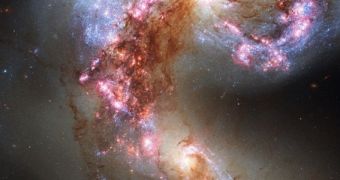Using its Wide Field Camera 3 (WFC3) and Advanced Camera for Surveys (ACS) instruments, the NASA Hubble Space Telescope was recently able to capture this magnificent image of the Antennae Galaxies, a pair of galaxies that are currently merging with each other.
The process most likely began several hundreds of millions of years ago, and will probably continue for more than a billion years into the future. Astronomers estimate that the Milky Way and Andromeda will require nearly 2 billion years to fuse once they start colliding, in about 2 billion years.
The Antennae Galaxies, made up of members NGC 4038 and NGC 4039, are widely considered to be among the most beautiful such formations in the Universe. They have captured people's attention ever since Hubble first captured them on camera, in 1997, and then again in 2006.
The collision between the two galaxies is so enormous and fast that they are both in a state of so-called starburst. This means that all available hydrogen gas in the objects is being stirred by the merger, and put to good use forming new stars. Intensely-blue areas in this image are actually clusters of newly-formed stars.

 14 DAY TRIAL //
14 DAY TRIAL //